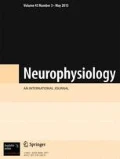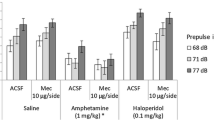Effects of transient inhibition of the core part of the nucl. accumbens (NAcC) by lidocaine on nicotineinduced conditioned place preference in male Wistar rats were examined. Lidocaine (2%) was injected into the NAcC of nicotine-conditioned animals before each nicotine i.p. injection. On the test day, behavior of the animals in a two-lcompartment apparatus was recorded during 10 min. Results revealed that i.p. injections of nicotine (1.0 or 1.5 mg/kg) induced place preference. Transient lidocaine-induced inhibition of one or both sides of the NAcC did not change place preference but changed the numbers of compartment crossings, rearings, and sniffings. Inhibition of the left part and both parts of the structure reduced sniffing and increased place preference; inhibition of the right part of the nucleus increased the intensity of this phenomena.
Similar content being viewed by others
References
G. Di Chiara, “Nucleus accumbens shell and core dopamine: differential role in behavior and addiction,” Behav. Brain Res., 137, Nos. 1/2, 75-114 (2002).
R. Spanagel and F. Welss, “The dopamine hypothesis of reward: Past and current status,” Trends Neurosci., 22, No. 11, 521-527 (1999).
P. Di Ciano, R. N. Cardinal, R. A. Cowell, et al., “Differential involvement of NMDA, AMPA/kainate, and dopamine receptors in the nucleus accumbens core in the acquisition and preformance of Pavlovian approach behavior,” J. Neurosci., 21 (23), 9471-9477 (2001).
L. Heimer, D. S. Zahm, L. Churchill, et al., “Specificity in the projection patterns of accumbal core and shell in the rat,” Neuroscience, 41, No. 1, 89-125 (1991).
D. S. Zahm, “Functional-anatomical implications of the nucleus accumbens core and shell subterritories,” Ann. New York Acad. Sci., 877, 113-128 (1999).
J. M. Brundege and J. T. Williams, “Differential modulation of nucleus accumbens synapses,” J. Neurophysiol., 88, No. 1, 142-151(2002).
D. Chalabi-Yani1, H. Sahraei, G. H. Meftahi, et al., “Effect of transient inactivation of ventral tegmental area on the expression and acquisition of nicotineinduced conditioned place preference in rats,” Iran. Biomed. J., 19, No. 4, 214-219 (2015).
K. S. Smith, A. J. Tindell, J. W. Aldridge, and K. C. Berridge, “Ventral pallidum roles in reward and motivation,” Behav. Brain Res., 196, No. 2, 155-167 (2009).
S. R. Sesack and V. M. Pickel, “In the rat medial nucleus accumbens, hippocampal and catecholaminergic terminals converge on spiny neurons and are in apposition to each other,” Brain Res., 527, No. 2, 266-279 (1990).
A. L. Jongen-Relo, H. J. Groenewegen, and P. Voorn, “Evidence for a multi-compartmental histochemical organization of the nucleus accumbens in the rat,” J. Comp. Neurol., 337, No. 2, 267-276 (1993).
G. E. Meredith, C. M. Pennartz, and H. J. Groenewegen, “The cellular framework for chemical signaling in the nucleus accumbens,” Prog. Brain Res., 99, 3-24 (1993).
G. E. Meredith, “The synaptic framework for chemical signaling in nucleus accumbens,” Ann. New York Acad. Sci., 877, 140-156 (1999).
F. E. Pontieri, G. Tanda, F. Orzi, and G. Di Chiara, “Effects of nicotine on the nucleus accumbens and similarity to those of addictive drugs,” Nature, 382, No. 6588, 255-257 (1996).
M. H. Esmaeili, H. Sahraei, H. Ali-Beig, et al., “Transient inactivation of the nucleus accumbens reduces both the expression and acquisition of morphine-induced conditioned place preference in rats,” Pharmacol. Biochem. Behav., 102, No. 2, 249-256 (2012).
I. Belcheva, S. Belcheva, V. V. Petkov, and V. D. Petkov, “Asymmetry in behavioral responses to cholecystokinin microinjected into rat nucleus accumbens and amygdala,” Neuropharmacology, 33, No. 8, 995-1002 (1994).
I. Belcheva, J. B. Bryer, S. E. Starkstein, et al., “Hemispheric asymmetry in behavioral response to D1 and D2 receptor agonists in the nucleus accumbens,” Brain Res., 533, No. 2, 286-291 (1990).
M. Moaddab, A. Haghparast, and M. Hassanpour- Ezatti, “Effects of reversible inactivation of the ventral tegmental area on the acquisition and expression of morphine-induced conditioned place preference in the rat,” Behav. Brain Res., 198, No. 2, 466-471 (2009).
G. Paxinos and D. Watson, The Rat Brain in Stereotaxic Coordinates, Acad. Press, New York (1987).
H. Sahraei, L. Etemadi, P. Rostami, et al., “GABA(B) receptors within the ventral tegmental area are involved in the expression and acquisition of morphineinduced place preference in morphine-sensitized rats,” Pharmacol. Biochem. Behav., 91, No. 3, 409-416 (2009).
E. Fedele, G. Varnier, M. A. Ansaldo, and M. Raiteri, “Nicotine administration stimulates the in vivo N-methyl-D-aspartate receptor/nitric oxide/cyclic GMP pathway in rat hippocampus through glutamate release,” Br. J. Pharmacol., 125, No. 5, 1042-1048 (1998).
A. A. Barzegari-Sorkheh, S. Oryan, and H. Sahraei, “The role of nitric oxide in nicotine reward: A place preference study in rats,” Afr. J. Pharm. Pharmacol., 6(34), 2544-2553 (2012).
M. Shoaib, I. P. Stolerman, and R. C. Kumar, “Nicotineinduced place preferences following prior nicotine exposure in rats,” Psychopharmacology, 113, Nos. 3/4, 445-452 (1994).
T. M. Tzschentke, “Measuring reward with the conditioned place preference (CPP) paradigm: update of the last decade,” Addict. Biol., 12, Nos. 3/4, 227-462 (2007).
G. Di Chiara, V. Bassareo, S. Fenu, et al., “Dopamine and drug addiction: the nucleus accumbens shell connection,” Neuropharmacology, 47, Suppl. 1, 227-241 (2004).
R. Diaz Heijtz and F. Xavier Castellanos, “Differential effects of a selective dopamine D1-like receptor agonist on motor activity and c-fos expression in the frontalstriatal circuitry of SHR and Wistar-Kyoto rats,” Behav. Brain Funct., 2:18 (2006).
M. B. Eklund, L. M. Johansson, K. Uvnäs-Moberg, and L. Arborelius, “Differential effects of repeated long and brief maternal separation on behavior and neuroendocrine parameters in Wistar dams,” Behav. Brain Res., 203, No. 1, 69-75 (2009).
A. Kepecs, N. Uchida, and Z. F. Mainen, “The sniff as a unit of olfactory processing,” Chem. Senses, 31, No. 2, 167-179 (2006).
F. Luther, “The research component in orthodontic education: sniffing out rats (SnOR),” J. Orthod., 32, No. 2, 73-74 (2005).
M. A. Gerrits, P. Petromilli, G. Westenberg, et al., “Decrease in basal dopamine levels in the nucleus accumbens shell during daily drug-seeking behavior in rats,” Brain Res., 924, No. 2, 141-150 (2002).
L. H. Sellings and P. B. Clarke, “Segregation of amphetamine reward and locomotor stimulation between nucleus accumbens medial shell and core,” J. Neurosci., 23, No. 15, 6295-6303 (2003).
M. T. Bardo, S. L. Bowling, J. K. Rowlett, et al., “Environmental enrichment attenuates locomotor sensitization, but not in vitro dopamine release, induced by amphetamine,” Pharmacol. Biochem. Behav., 51, Nos. 2/3, 397–405 (1995).
M. T. Bardo, P. M. Robinet, and R. F. Hammer, Jr., “Effect of differential rearing environments on morphine-induced behaviors, opioid receptors and dopamine synthesis,” Neuropharmacology, 36, No. 2, 251–259 (1997).
J. M. Bossert, G. C. Poles, K. A. Wihbey, et al., “Differential effects of blockade of dopamine D1-family receptors in nucleus accumbens core or shell on reinstatement of heroin seeking induced by contextual and discrete cues,” J. Neurosci., 27, No. 46, 12655-12663 (2007).
S. Ikemoto, M. Qin, and Z. H. Liu, “The functional divide for primary reinforcement of D-amphetamine lies between the medial and lateral ventral striatum: Is the division of the nucleus accumbens core, shell, and olfactory tubercle valid?” J. Neurosci., 25, No. 20, 5061-5065 (2005).
Author information
Authors and Affiliations
Corresponding authors
Rights and permissions
About this article
Cite this article
Hosseini, S.B., Sahraei, H., Mohammadi, A. et al. Inactivation of the Nucl. Accumbens Core Exerts No Effect on Nicotine-Induced Conditioned Place Preference. Neurophysiology 47, 295–301 (2015). https://doi.org/10.1007/s11062-015-9536-8
Received:
Published:
Issue Date:
DOI: https://doi.org/10.1007/s11062-015-9536-8




